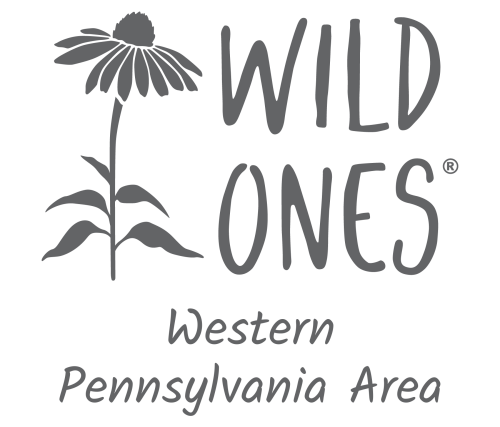Violets (Viola spp.) are a host plants for five fritillaries in western Pennsylvania, four of which are common to all violets and one, regal fritillary, is hosted by the bird-foot violet (Viola pedata). In the spring, violets have white, blue, violet, and yellow flowers. These herbs, which provide taller structure, can be a vital part of your butterfly garden in western Pennsylvania. The genus name, Viola, derives from the Latin word for “sweet-scented flowers.” All of the species discussed in this post can be grown in western Pennsylvania.
General Information about Native Plant and Pollinator Gardens
When planting a native plant and pollinator garden in western Pennsylvania, you need to ensure that you have a selection of plants that attract other butterflies at different time of the year. Besides violets, other host plants that attract other butterflies and pollinators should be considered. These could include pawpaw (Asimina triloba) for zebra swallowtail, wild cherry (Prunus serotina) for eastern tiger swallowtails, and trumpet creeper (Campsis radicans) for hummingbirds.
In addition to the plants, you need to provide a source of water such as a birdbath or water feature, shelter for animals, and nesting locations for birds. Be sure to include plants of different heights for perching. Resources you can use for more information on butterfly gardening in western Pennsylvania include the Penn State Master Gardeners of Allegheny County, Wild Ones Western Pennsylvania Chapter, Audubon Society of Western Pennsylvania, Xerces Society, and Phipps Conservatory and Botanical Garden.
USDA Plant Hardiness Zones and location of Western Pennsylvania
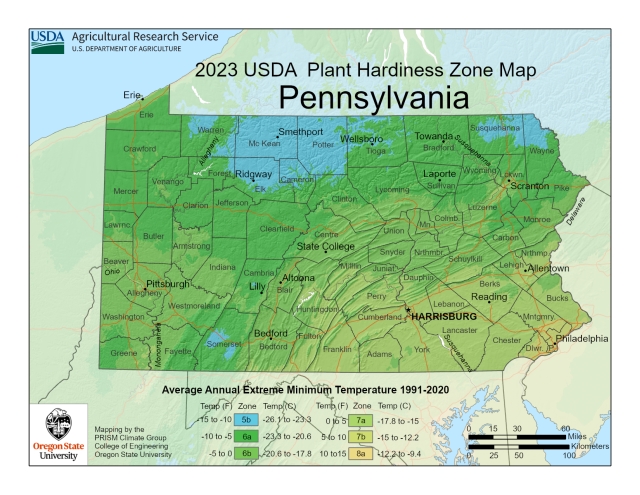
Western Pennsylvania extends from Ohio to roughly just east of State College, PA. Most of the region is located within zones 5 to 7. When violets in Western Pennsylvania, you will want to get those that can handle temperatures as cold as -150F in the northern areas, such as McKean, Potter, and Elk counties to +50F in the southern areas, such as Fulton and Huntingdon counties.
Butterflies in Western Pennsylvania that are hosted by Violets (Viola spp.)

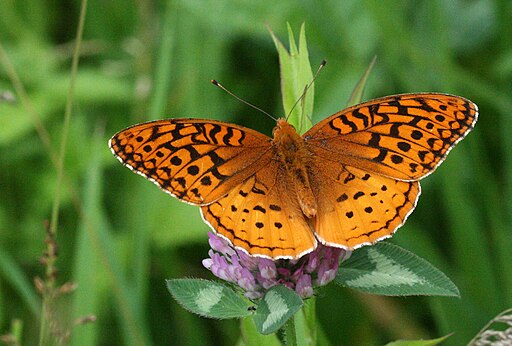
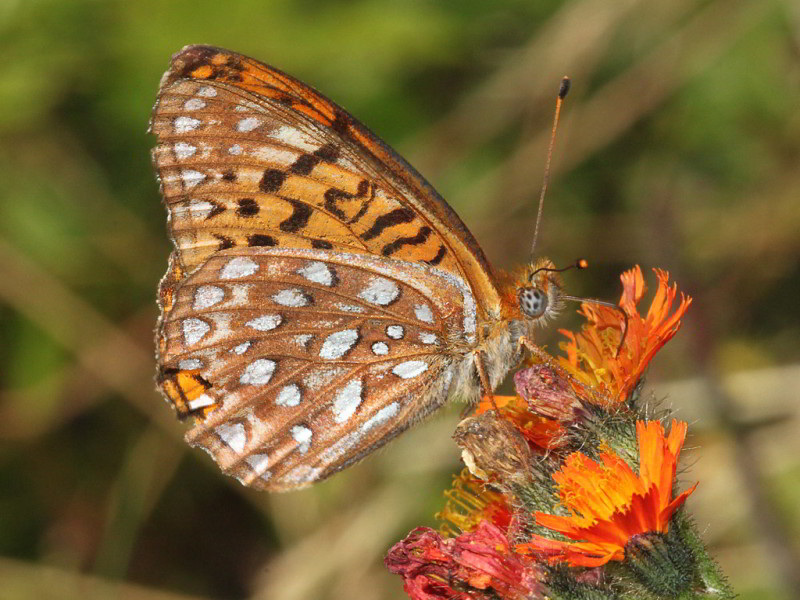
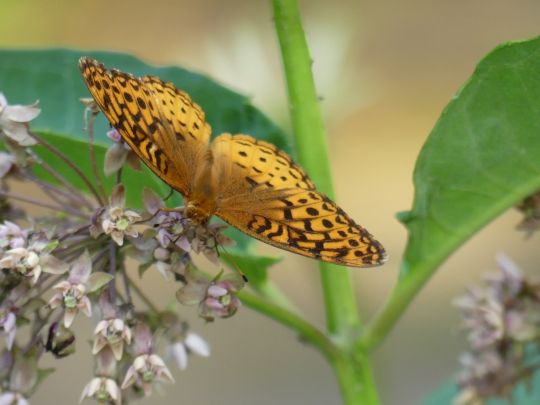
Silver-bordered Fritillary (Boloria selene)
The Silver-bordered fritillary has an orange with brown spots upperside and an underside that has silver colored spots. As an adult it is a small butterfly with a wingspan of 1.4 in (3.5 cm) to 2.1 in (5.4 cm) and the males tend to be smaller than the females. There is one brood each year, which come out from May to August.
The eggs are laid on or near the host plants. The larva are brownish-red in color with orange spines and overwinter under leaves. There is one brood each year and pupation is from May to August.
Aphrodite Fritillary (Speyeria aphrodite)
The Aphrodite Fritillary has is orange-brown on the upperside and brown with white spots on the underside. Adults have a wingspan of 2.5 in (6.3 cm) to 3.3 in (8.3 cm). There is one brood per year from June to September.
The eggs are laid under brush near the host plants. Larva are blackish-brown with black bands (Pyle 1981) and they have green or brown larvae. This species can have up to three broods throughout the growing season.
Atlantis Fritillary (Speyeria atlantis)
The Atlantis Fritillary is a orange-brown with a black dot on the inner wing. The forewings have black margins and the underside is a purplish brown color (Bouseman and Sternburg 2001). A fully grown adult has a wingspan of 2.0 in (5.1 cm) to 3.0 in (7.6 cm).
The honey yellow eggs are laid at the base of the host plants (Viola spp.). Larvae are tan colored and overwinter under leaf litter. The chrysalis is dark brown and is attached to rocks or branches.
Great Spangled Fritillary (Speyeria cybele)
The Great Spangled Fritillary is an orange and brown spotted butterfly on the upperside and a silver metallic underside. This butterfly is found in the middle and northern of the United States and the southern parts of Canada. Adults have a wingspan of 2.4 in (6.2 cm) to 4 in (10.2 cm).
The eggs of this species are yellow to light brown and are laid near the host plant. The caterpillars are black with orange spines and overwinter underneath leaf litter. There is one brood that flies from May to October.
List of Violets that are Native or Nearly Native in Western Pennsylvania
1. Sand Violet (Viola affinis), a Violet for Medium to Moist Well-drained Soils
When planted in a butterfly garden, this species does best in places that are partially shaded with dappled sunlight or morning sun with afternoon shade. You should avoid planting them in full sun, which would dry their leaves. Soil conditions should be moist to wet and well-drained. Once established they can handle drier soil. Slugs and snails may eat the foliage this plant. These plants need to be given room as they are known to spread.
Suitable settings for sand violet include woodland gardens, stream banks and ponds, and rain gardens. Companion plants can include ferns such as maidenhair fern (Adiantum pedatum), Christmas fern (Polystichum acrostichoides), bloodroot (Sanguinaria canadensis), Virginia bluebell (Mertensia virginica), and Pennsylvania sedge (Carex pennsylvanica). The flowers for this plant will only be visible in the spring.
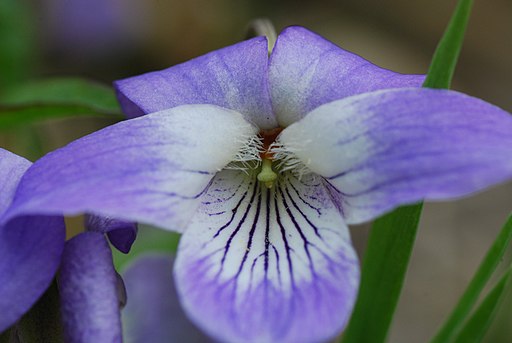
Facts about Sand Violet
- Native to Pennsylvania: Yes (Kartesz 2015)
- Native to Western Pennsylvania: Yes
- Natural Habitat: wetlands, bottomland woods (Ward 2006), rock talus (Fernald and Wiegand 1923), edges of woods (Blake 1913), and rich pine woods (Weatherby and Griscom 1934)
- Height: up to 1 ft (0.3 m)
- Flower Color: blue, purple, to reddish
- Flowering Period: April to May
- USDA Hardiness Zone: 5-10
Gardening with Sand Violet
In your western Pennsylvania butterfly garden this plant requires places with part-shade to shade and average to moist well-drained soils.
2. Field Pansy (Viola bicolor), a Violet for Medium to Moist Well-Drained Soils
As the common name of the plant would suggest, this species prefers open areas, such as fields, meadows, and woodland edges, where it can take advantage of full sun, though it can handle some partial shade. Soils should be moist and well-drained. However, they can handle drier conditions, once established. This species self-seeds readily and can remain in the garden for many years.
Suitable areas for field pansy incude open areas, woodland edges, and rain gardens. Companion plants can include wild bergamot (Monarda fistulosa), black-eyed susan (Rudbeckia hirta), for more year-round color, and butterfly weed (Asclepias tuberosa). Make sure that any plant chosen does not overwhelm the violets in height and width.

Facts about Field Pansy
- Native to Pennsylvania: Yes, mainly the southern counties, scattered in north (Kartesz 2015)
- Native to Western Pennsylvania: Yes
- Natural Habitat: prairies, open woodlands, fields, roadsides, and lawns
- Height: < 6 inches (15.2 cm)
- Flower Color: blue to white with purple veins
- Flowering Period: March to May
- USDA Hardiness Zone: 4-10
Gardening with Field Pansy
In your western Pennsylvania butterfly garden, this plant requires full sun to part shade and medium to moist well-drained soils.
3. Sweet White Violet (Viola blanda), a Violet for Moist to Wet Soils
Sweet white violets can often be found growing in shady places that are moist and well-drained. Like the sand violet, too much sun, can dry out the leaves of this species. Sweet white violets spread via rhizomes and are also self-seeding guaranteeing that you will have this plant survive in your garden. These plants are known to be deer-resistant, so if you have browsing pressure, this may be the violet for you.
Suitable areas to grow sweet white violet include woodland gardens, stream banks and shady slopes, and understory plantings. Companion plants can include are similar to those for the sand violet, including sand violet, plus wild ginger (Asarum canadense) and foamflower (Tiarella cordifolia).
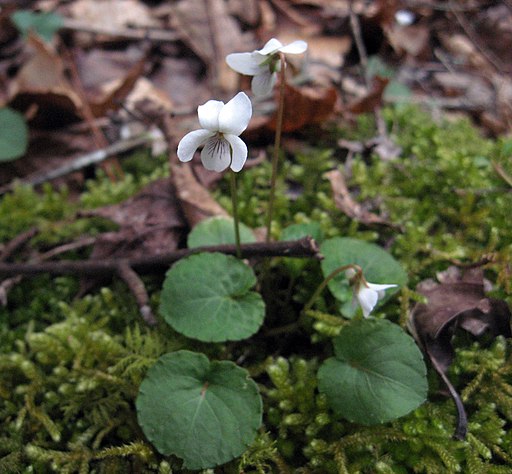
Facts about Sweet White Violet
Viola blanda var. blanda and var. palustriformis in Pennsylvania
- Native to Pennsylvania: Yes, throughout (Kartesz 2015)
- Native to Western Pennsylvania: Yes
- Natural Habitat: Rich woods, stream edges (Bendrat 1913), shaded undisturbed forests (Russell 1965 and Moldenke 1945), and damp woods (King 1912)
- Height: up to 8 inches (20 cm)
- Flower Color: white
- Flowering Period: April to June
- USDA Hardiness Zone: 2-7
Gardening with Sweet White Violet
In your western Pennsylvania butterfly garden, this plant requires part shade and moist to wet well-drained soils. This violet has a slight fragrance, if you get close to it.
4. Canada White Violet (Viola canadensis), a Violet for Medium to Moist Soils
Canada violet generally grows in places of full sun or partial shade. It is often found in lawns and likes moist soils that are well-drained, but can handle drier places once it is established. This violet spreads via rhizomes and self-seeding. Alternatively, the clumps can be divided to produce new plantings. This is another deer-resistant plant that can be used in places with a high deer population.
Suitable settings for Canada white violet include woodland gardens, shaded lawns, shady slopes and stream banks, and understories. Companion plants are similar to the sweet white violet, plus spicebush (Lindera benzoin) and red-osier dogwood (Cornus sericea) to provide some shade.
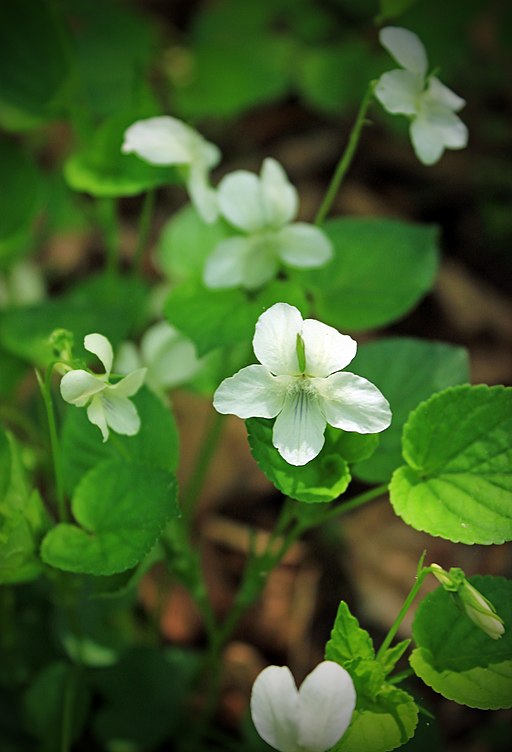
Facts about Canada Violet
- Native to Pennsylvania: Yes, generally throughout (Kartesz 2015)
- Native to Western Pennsylvania: Yes
- Natural Habitat: bottomland forests, pine forests (Russell 1965), lawns, roadsides
- Height: 4 in (11 cm) to 18 in (46 cm)
- Flower Color: white
- Flowering Period: April to October
- USDA Hardiness Zone: 3-8
Gardening with Canada Violet
In your western Pennsylvania butterfly garden, this plant requires part shade to shade and soils that are medium to moist and well-drained.
5. Wetland Blue Violet (Viola cucullata), a Violet for Moist to Wet Soils
The common name of this plant is suggestive of the moist to wet soils that are needed for this species. Beyond liking wet soils it can handle places with poor drainage and seasonal flooding. This species can handle full sun to partial shade, but prefers shade in hotter places. Like a number of other violets, this species spreads via rhizomes and self-seeding and is deer-resistant.
Suitable settings for wetland blue violet include wetlands and bogs, stream banks and pond margins, and rain gardens. Companion plants that can handle the wet conditions include cardinal flower (Lobelia cardinalis), marsh marigold (Caltha palustris), and joe-pye weed (Eutrochium spp.).
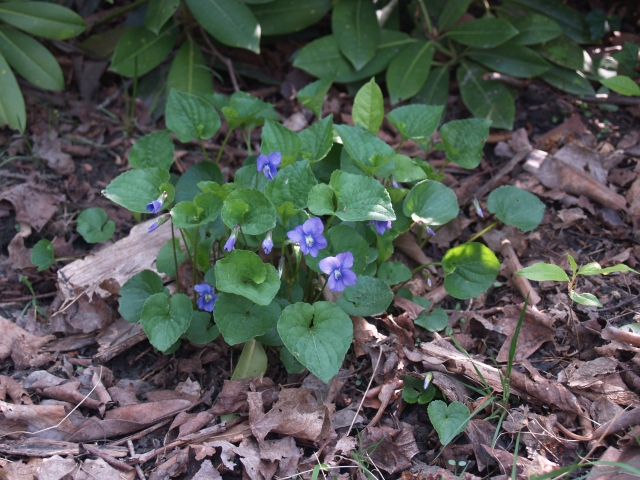
Facts about Wetland Blue Violet
- Native to Pennsylvania: Yes, throughout (Kartesz 2015)
- Native to Western Pennsylvania: Yes
- Natural Habitat: wooded areas, streamsides (Macoun 1898), and wetlands
- Height: 2 in (5 cm) to 7.9 in (20 cm)
- Flower Color: light blue violet to violet
- Flowering Period: April to June
- USDA Hardiness Zone: 3-7
Gardening with Wetland Blue Violet
In your western Pennsylvania butterfly garden, this plant requires full sun to partial shade and moist to wet well-drained soils. This plant has brillant blue flowers in the spring.
6. Halbeard-leaf Violet (Viola hastata), a Violet for Occasionally Dry to Moist Soil
Halbeard-leaf violet perfers shaded places having dappled sunlight or morning sun with afternoon shade. If planted in full sun the leaves may dry out. Soils should be moist and well-drained, but this species can handle drier conditions once established. Like a number of other violets here, this species spread via rhizomes and self-seeds.
Suitable settings for halbeard-leaf violet include woodland gardens, shaded slopes and ravines, and understory plantings. Companion plants for halbeard-leaf violet include ferns such as maidenhair fern (Adiantum pedatum), and Christmas fern (Polystichum acrostichoides), bloodroot (Sanguinaria canadensis), trillium (Trillium sp.), wild ginger (Asarum canadense), and foamflower (Tiarella cordifolia).
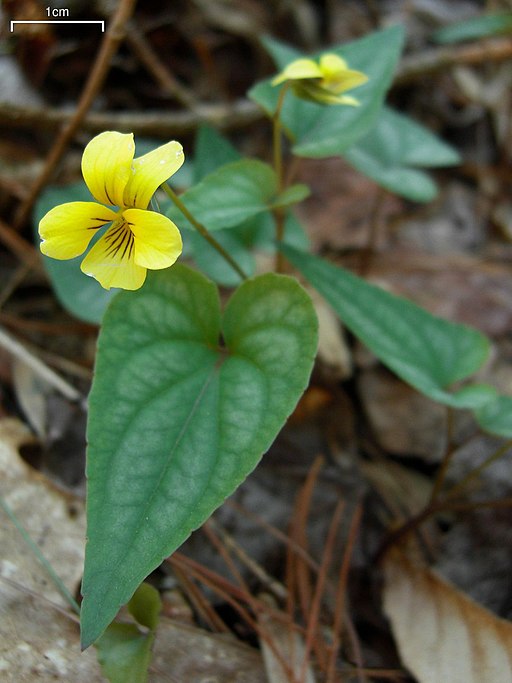
Facts about Halbeard-leaf Violet
- Native to Pennsylvania: Yes, western Pennsylvania (Kartesz 2015)
- Native to Western Pennsylvania: Yes
- Natural Habitat: Rich woods
- Height: 2 in (5 cm) to 11.8 in (30 cm)
- Flower Color: yellow
- Flowering Period: March to May
- USDA Hardiness Zone: 4-7
Gardening with Halbeard-leaf Violet
In your western Pennsylvania butterfly garden, this plant requires full sun to shade and ocassionally dry to moist well-drained soils.
7. Southern Woodland Violet (Viola hirsutula), a Violet for Dry to Medium Soils
Southern woodland violet grows on rocky wooded slopes and as such likes places that are shaded with dappled sunlight or having morning sun with afternoon shade. The leaves of this species can dry out in full sun. Soils should medium and well-drained, but it can handle drier conditions once established. Like the other violets, this species spread via rhizomes and self-seeding.
Suitable settings for southern woodland violet include woodland gardens, shady slopes and ravines, and understory plantings. Companions to this species are similar to those of the halbeard-leaf violet.
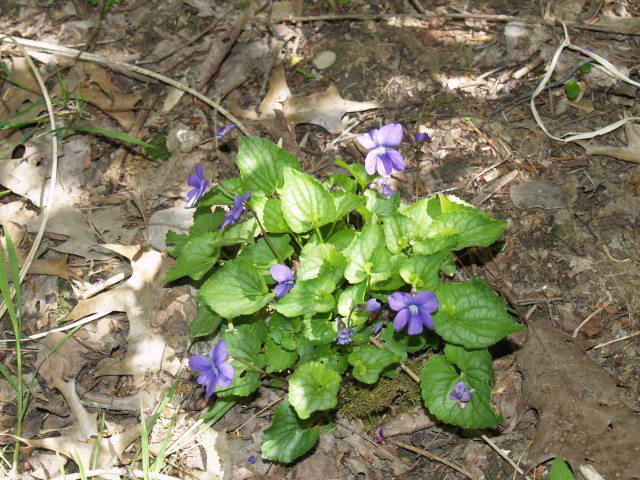
Facts about Southern Woodland Violet
- Native to Pennsylvania: Yes, thoroughout, except northern counties (Kartesz 2015)
- Native to Western Pennsylvania: Yes
- Natural Habitat: rocky open woods
- Height: 1 in (2.5 cm) to 5.9 in (15 cm)
- Flower Color: reddish violet to blue-violet
- Flowering Period: March to June
- USDA Hardiness Zone: 6-9
Gardening with Southern Woodland Violet
In your western Pennsylvania butterfly garden, this plant requires part-shade and dry to medium well-drained soils.
8. Alpine Violet (Viola labradorica), a Violet for Medium to Moist Well-drained Soils
Alpine violet or Labrador violet as the name would suggest, grows in more northern parts of North America. It likes places having full sun to part shade and soils that are medium to moist and are well-drained. In western Pennsylvania, this species does better having more shade than sun, especially in the more southern parts of the region.
Suitable settings for labrador violet include woodland gardens, rock gardens, understories, and between the rocks on paths. Companion plants are similar to the previous two violets dicussed, halbread-leaf violet and southern woodland violet.
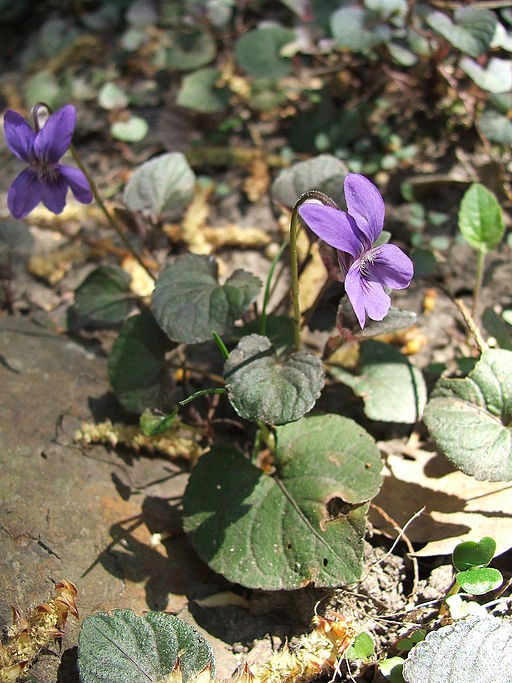
Facts about Alpine Violet
- Native to Pennsylvania: Yes, throughout (Kartesz 2015)
- Native to Western Pennsylvania: Yes
- Natural Habitat: moist woods, old fields and roadsides (Knowlton 1915), damp open or shady places (Arsène 1927), and sedge meadows (Bouchard and Hay 1976)
- Height: 1 in (2.5 cm) to 7.9 in (20 cm)
- Flower Color: lavender-violet to white
- Flowering Period: April to August
- USDA Hardiness Zone: 3-8
Gardening with Alpine Violet
In your western Pennsylvania butterfly garden, this plant requires full sun to part shade and medium to moist well-drained soils.
9. Bog White Violet (Viola lanceolata), a Violet for Moist to Wet Soils
Bog white violet can handle full sun in more northern areas, but in western Pennsylvania it can thrive in partial shade such as places with dappled sunlight or having morning sun and afternoon shade. Soils should be moist to wet and acidic with organic matter.
Suitable settings for bog white violet include bogs and wetlands, stream banks and pond margins, and rain gardens. Companion plants can include cardinal flower (Lobelia cardinalis), marsh marigold (Caltha palustris), and for added interest, sundews (Drosera spp.). In wetlands, this plant can spread aggresively so you might want to monitor it, if planted.
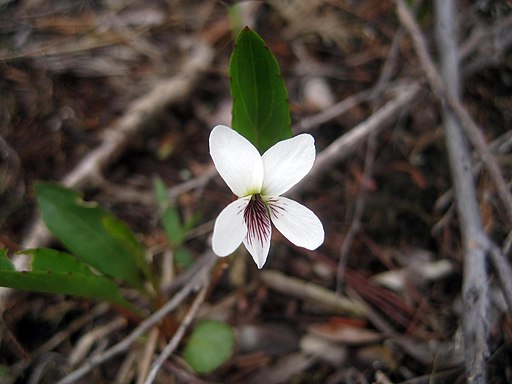
Facts about Bog White Violet
Viola lanceolata ssp. lanceolata in Pennsylvania
- Native to Pennsylvania: Yes, throughout, except northern counties (Kartesz 2015)
- Native to Western Pennsylvania: Yes
- Natural Habitat: bogs, swamps, wet meadows (King 1912), and moist shores
- Height: 2 in (5 cm) to 11.8 in (30 cm)
- Flower Color: white with purple veins
- Flowering Period: March to May
- USDA Hardiness Zone: 7-10
Gardening with Bog White Violet
In your western Pennsylvania butterfly garden, this plant requires part-shade to shade and soils that are moist to wet.
10. Smooth White Violet (Viola macloskeyi), a Violet for Moist to Wet Soils
Smooth white violet likes places with full shade or those places with morning sun and afternoon shade. Soils should be moist to wet and have a high amount of organic matter.
Suitable settings include woodlands, streambanks and shady banks, and understories. Companion plants include those for the halbeard-leaf violet.
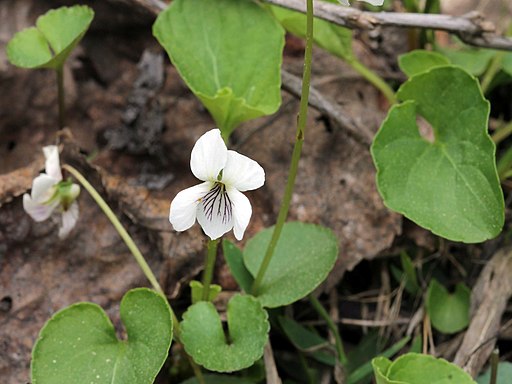
Facts about Smooth White Violet
Viola macloskeyi ssp. macloskeyi in Pennsylvania
- Native to Pennsylvania: Yes, thoroughout (Kartesz 2015)
- Native to Western Pennsylvania: Yes
- Natural Habitat: forests, wetlands, streambanks, and meadows
- Height: 0.8 in (2 cm) to 5 in (10 cm)
- Flower Color: white with purple veins
- Flowering Period: March to September
- USDA Hardiness Zone: 2-7
Gardening with Smooth White Violet
In your Western Pennsylvania butterfly garden, this plant requires full sun to shade and soils that are moist to wet.
11. Three-lobe Violet (Viola palmata), a Violet for Medium to Dry Soils
Three-lobe violet prefers places with partial to full shade. In western Pennsylvania, the best conditions are those with morning sun and afternoon shade. Any more sun could dry out the leaves. Soils should be medium to dry and preferably rocky.
Suitable settings include woodland gardens, shady ravines, and understories. Companion plants are similar to those for the halbeard-leaf violet.
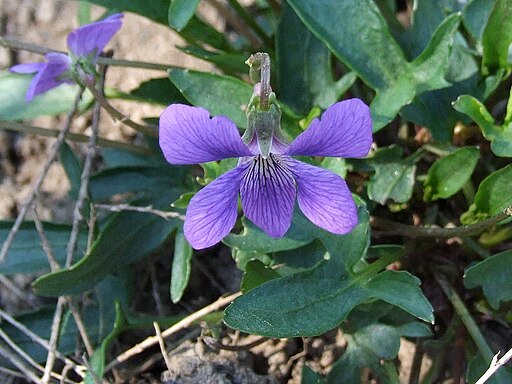
Facts about Three-lobe Violet
Viola palmata var. palmata in western Pennsylvania
- Native to Pennsylvania: Yes, generally thoroughout, except northwest (Kartesz 2015)
- Native to Western Pennsylvania: Yes
- Natural Habitat: open rocky woodlands, wooded bluffs, railroads, roadsides
- Height: 2.4 in (6 cm) to 19.7 in (50 cm)
- Flower Color: purple
- Flowering Period: April to May
- USDA Hardiness Zone: 4-9
Gardening with Three-lobe Violet
In your Western Pennsylvania butterfly garden, this plant requires partial to full shade and medium to dry soils.
12. Bird-foot Violet (Viola pedata), a Violet for Medium to Dry Well-drained Soils
Bird-foot violet thrives in places of full sun or partial shade that have medium to dry well-drained soils. In western Pennsylvania, full sun is ideal. This species hosts the regal fritillary (Speyeria idalia), a rare butterfly in Pennsylvania.
Suitable settings include rock gardens, sunny meadows and prairies, and sandy or gravelly slopes. Possible companion plants that can handle a drier situation include pussytoes (Antennaria spp.), wild lupine (Lupinus perennis), little bluestem (Schizachyrium scoparium), and butterfly weed (Asclepias tuberosa).
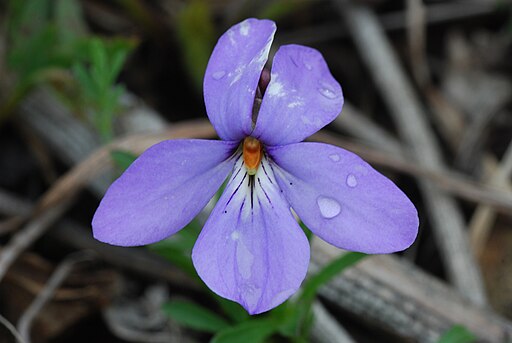
Facts about Bird-foot Violet
- Native to Pennsylvania: Yes, south-central and east (Kartesz 2015)
- Native to Western Pennsylvania: Yes, Bedford and Fulton counties
- Natural Habitat: rocky woods, oak woods (Wofford, et al 1979), and roadsides
- Height: 3 in (7.6 cm) to 6 in (15.2 cm)
- Flower Color: purple
- Flowering Period: March to May
- USDA Hardiness Zone: 4-8
Gardening with Bird-foot Violet
In your western Pennsylvania butterfly garden, this plant requires full sun to partial shade and soils that are medium to dry and well-drained.
13. Primroseleaf Violet (Viola primulifolia), a Violet for Moist Soils
Primroseleaf violet prefers places with partial shade to full shade and soils that are moist to wet and acidic with a high amount of organic matter. This species spreads by stolons and by self-seeding.
Suitable settings for this species include bogs and wetlands, stream banks and pond margins, and rain gardens. Companion plants are generally those that can handle wetlands such as cardinal flower (Lobelia cardinalis), marsh marigold (Caltha palustris), turtlehead (Chelone glabra), and cinnnamon fern (Osmunda cinnamomea).
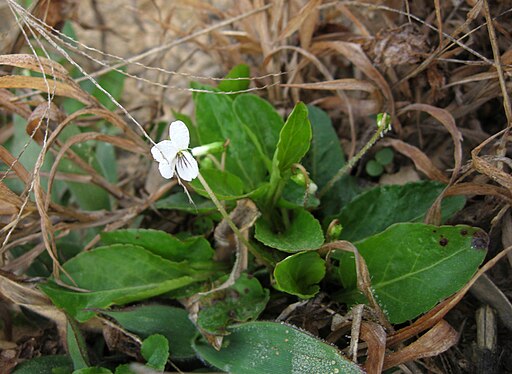
Facts about Primroseleaf Violet
- Native to Pennsylvania: Yes, thoroughout (Kartesz 2015)
- Native to Western Pennsylvania: Yes
- Natural Habitat: prairies, savannas, bogs (Mac Elwee 1900), and openings in woodlands
- Height: 1.2 in (3 cm) to 14.2 in (36 cm)
- Flower Color: white with purple veins
- Flowering Period: March to May
- USDA Hardiness Zone: 6-10
Gardening with Primroseleaf Violet
In your western Pennsylvania butterfly garden, this plant requires partial shade to full shade and moist soils.
14. Downy Yellow Violet (Viola pubescens), a Violet for Medium to Moist Well-drained Soils
Downy yellow violet requires partial shade to shade and medium to moist soils having a high amount of organic matter. This species spreads via rhizomes and self-seeding.
Suitable settings for downy yellow violet include woodland gardens, shady slopes and ravines, and in understory plantings. Companion plants are similar to those for the halbeard-leaf violet (Viola hastata) with the addition of some shrubs such as spicebush (Lindera benzoin) and/or dogwood (Cornus spp.) for additional shading.
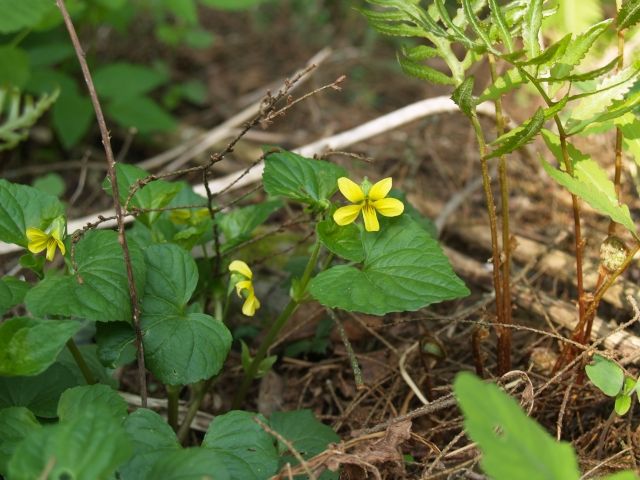
Facts about Downy Yellow Violet
- Native to Pennsylvania: Yes, thoroughout (Kartesz 2015)
- Native to Western Pennsylvania: Yes
- Natural Habitat: shaded forests, woodlands, meadows
- Height: 3.9 in (10 cm) to 17.7 in (45 cm)
- Flower Color: yellow
- Flowering Period: April to June
- USDA Hardiness Zone: 3-8
Gardening with Downy Yellow Violet
In your western Pennsylvania butterfly garden, this plant requires partial shade to shade and soils that are medium to moist and well-drained.
15. Long-spur Violet (Viola rostrata), a Violet for Moist Well-drained Soils
The conditions for long-spur violet are similar to those of the downy yellow violet in that it requires partial shade to shade and moist well-drained soils. Long-spur violet spreads via rhizomes and self-seeding, but it is not aggressive.
Suitable settings include woodland gardens, rock gardens, shaded areas, and understories. Companion plants are essentially the same as those for the downy yellow violet.
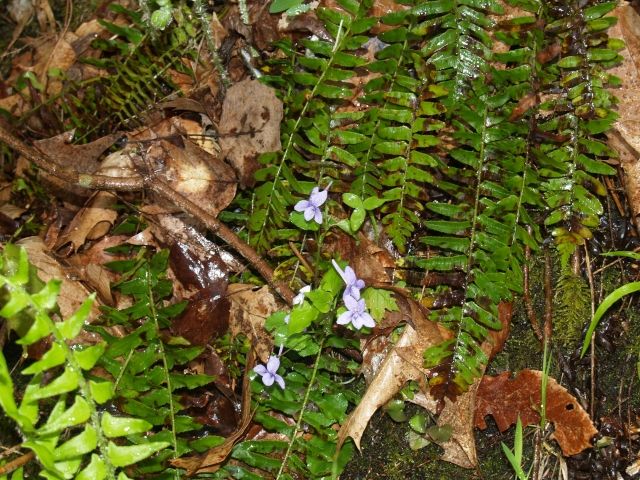
Facts about Long-spur Violet
- Native to Pennsylvania: Yes, thoroughout, except for the southeast and southwest counties (Kartesz 2015)
- Native to Western Pennsylvania: Yes
- Natural Habitat: forested areas with shade
- Height: 6 in (15.2 cm) to 8 in (20.3 cm)
- Flower Color: white with purple veins
- Flowering Period: March to September
- USDA Hardiness Zone: 2-7
Gardening with Long-spur Violet
In your western Pennsylvania butterfly garden, this plant partial shade to shade and moist well-drained soils.
16. Round-leaf Violet (Viola rotundifolia), a Violet for Medium to Wet Well-drained Soils
Round-leaf violet generally requires full shade in rich woods that have medium to wet well-drained soils. This species spreads via rhizomes and self-seeding.
Suitable settings for round-leaf violet include woodland gardens, wildflower areas, and cottage gardens. Companion plants are similar to those of the downy yellow violet and any other plants that can handle full shade.
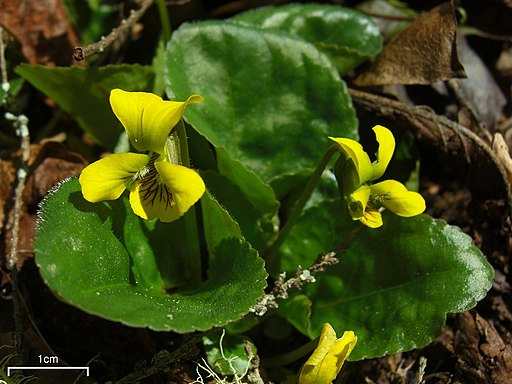
Facts about Round-leaf Violet
- Native to Pennsylvania: Yes, thoroughout, except for south-central counties (Kartesz 2015)
- Native to Western Pennsylvania: Yes
- Natural Habitat: Rich woods
- Height: 3 in (7.6 cm) to 6 in (15.2 cm)
- Flower Color: yellow with purple veins
- Flowering Period: March to April
- USDA Hardiness Zone: 3-7
Gardening with Round-leaf Violet
In your western Pennsylvania butterfly garden, this plant requires full sun to shade and soils that are moist to wet.
17. Arrow-leaf Violet (Viola sagittata), a Violet for Medium to Wet Well-drained Soils
Unlike a number of the other violets, arrow-leaf violet can handle full sun, but also partial shade. Soils should be medium to wet and well-drained. Spreading is through seed.
Suitable settings for arrow-leaf violet include meadows, rock gardens, and open woodlands. Possible companion plants can include pussytoes (Antennaria spp.), lupine (Lupinus perennis), little bluestem (Schizachyrium scoparium), switchgrass (Panicum virgatum), and milkweed (Asclepias spp.).
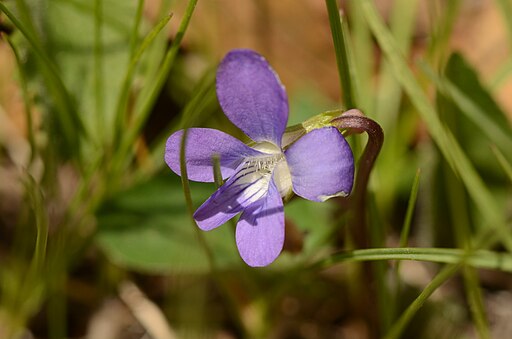
Facts about Arrow-leaf Violet
Viola sagittata var. ovata and Viola sagittata var. sagittata in Pennsylvania
- Native to Pennsylvania: Yes, thoroughout (Kartesz 2015)
- Native to Western Pennsylvania: Yes
- Natural Habitat: open areas such as prairies, glades, woodlands, bogs (Cowles 1901), wet meadows (King 1912), and swamp edges
- Height: 4 in (10.2 cm) to 8 in (20.3 cm)
- Flower Color: purple to light purple
- Flowering Period: April to June
- USDA Hardiness Zone: 2-7
Gardening with Arrow-leaf Violet
In your western Pennsylvania butterfly garden, this plant requires full sun to partial shade and soils that are medium to wet and well-drained.
18. Northern Woodland Violet (Viola septentrionalis), a Violet for Medium to Dry Soils
Northern woodland violet, as the name suggests, grows in more northern areas of North America. This species is found places of full sun to partial shade and requires medium to dry soils. The plants spread via rhizomes or self-seeding.
Suitable settings include woodland gardens, shaded woods, and understories. Possible companion plants are similar to those of the downy yellow violet (Viola pubescens).
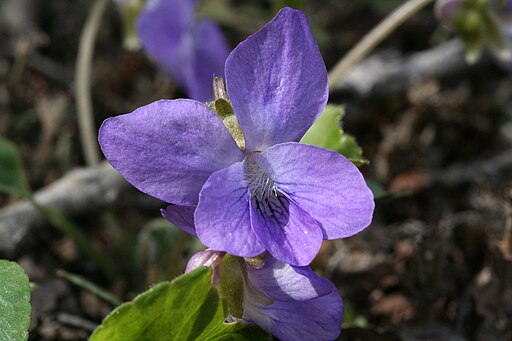
Facts about Northern Woodland Violet
- Native to Pennsylvania: Yes, scattered generally in northern counties (Kartesz 2015)
- Native to Western Pennsylvania: Yes
- Natural Habitat: mesic to dry woods on limestone
- Height: to 11 in (29 cm)
- Flower Color: lavender to purple
- Flowering Period: May to June
- USDA Hardiness Zone: 3-7
Gardening with Northern Woodland Violet
In your Western Pennsylvania butterfly garden, this plant requires full sun to partial shade and medium to dry soils.
19. Common Blue Violet (Viola sororia), a Violet for all Soils
Common blue violet can handle most garden conditions in exposure and soil. This species can be weedy in lawns and in your garden, but is a nice flower to have in the early spring.
Suitable settings include woodland gardens, rock gardens, meadows, and bedding plants. Companion plants can include those described for the other violet species.
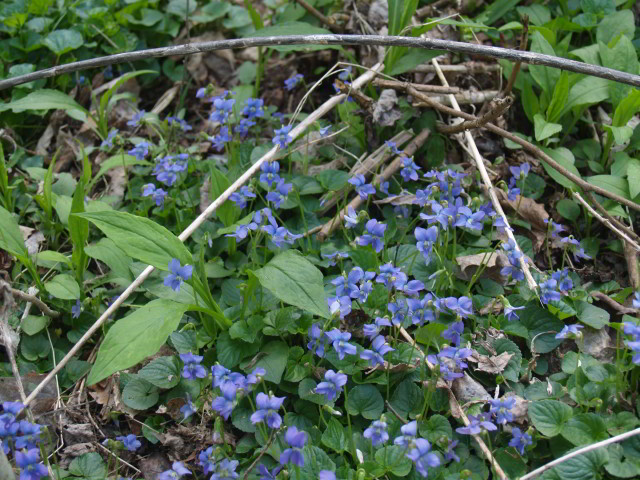
Facts about Common Blue Violet
- Native to Pennsylvania: Yes, thoroughout (Kartesz 2015)
- Native to Western Pennsylvania: Yes
- Natural Habitat: Woods, thickets, disturbed areas, lawns, roadsides
- Height: 2 in (5 cm) to 19.7 in (50 cm)
- Flower Color: blue to purple
- Flowering Period: March to June
- USDA Hardiness Zone: 2-7
Gardening with Common Blue Violet
In your Western Pennsylvania butterfly garden, this plant is very flexible and can be grown pretty much anywhere.
20. Striped Cream Violet (Viola striata), a Violet for Medium to Wet Well-drained Soils
Striped cream violet enjoys places with partial shade and medium to wet well-drained soils. This plant vigorously self-seeds.
Suitable settings for striped cream violet include woodland gardens, rock gardens, and shaded beds. Companion plants are similar to those for the halbeard-leaf violet (Viola hastata).
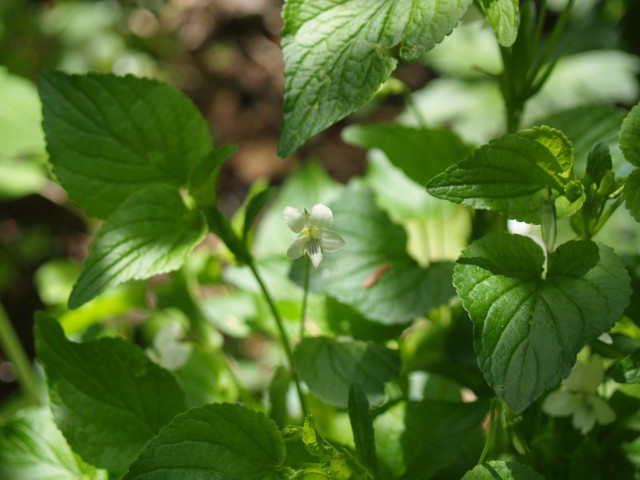
Facts about Striped Cream Violet
- Native to Pennsylvania: Yes, thoroughout (Kartesz 2015)
- Native to Western Pennsylvania: Yes
- Natural Habitat: woodlands, meadows, moist thickets (King 1912), and stream banks
- Height: 8 in (20.3 cm) to 12 in (30.5 cm)
- Flower Color: creamy-white with light purple veins
- Flowering Period: March to September
- USDA Hardiness Zone: 4-7
Gardening with Striped Cream Violet
In your western Pennsylvania butterfly garden, this plant partial shade and medium to moist well-drained soils.
21. Early Blue Violet (Viola subsinuata), a Violet for Medium to Moist Well-drained Soils
Early blue violet requires places with partial shade having medium to moist well-drained soils.
Suitable settings include woodland gardens, rock gardens, and beds that have circumneutral soils. Companion plants are similar to those of the downy yellow violet (Viola pubescens).
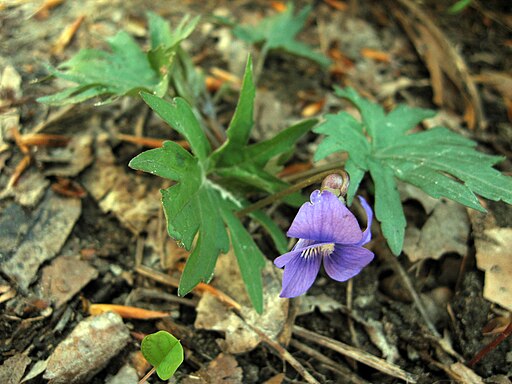
Facts about Early Blue Violet
- Native to Pennsylvania: Yes, generally eastern and southern counties (Kartesz 2015)
- Native to Western Pennsylvania: Yes
- Natural Habitat: rich woods and forests
- Height: 4 in (10 cm) to 12 in (30.5 cm)
- Flower Color: blue to purple
- Flowering Period: April to June
- USDA Hardiness Zone: 5-8
Gardening with Early Blue Violet
In your Western Pennsylvania butterfly garden, this plant requires full sun to shade and soils that are moist to wet.
References
- Arsène, Louis Brother. 1927. Contribution to the Flora of the Islands of St. Pierre et Miquelon. Rhodora 29: 173-191.
- Bendrat, T.A. 1913. The Flora of Mohawk Hill, N.Y., North of the Watershed. Torreya 13(3): 45-63.
- Blake, S.F. 1913. Six Weeks’ Botanizing in Vermont – I. Notes on the Plants of the Burlington Region. Rhodora 15: 153-168.
- Bouseman, John K. and James G. Sternburg. 2001. Field Guide to the Butterflies of Illinois. (Champaign, IL: Illinios Natural History Survey. Manual 10.
- Bouchard, André and S. Hay. 1976. The Vascular Flora of the Gros-Morne National Park Coastal Plain in Newfoundland and Canada. Rhodora 78: 207-260.
- Cowles, Herny Chandler. 1901. The Physiographic Ecology of Chicago and Vicinity; A Study of the Origin, Development, and Classification of Plant Societies (Concluded). Botanical Gazette 31 (3): 145-182.
- Fernald, Merritt Lyndon, and K.M. Wiegand. 1923. Notes on some plants of the Ontario and St. Lawrence Basins, New York. Rhodora 25: 205-214.
- King, Wilbur L. 1912. The Flora of Northamption County, Pennsylvania. Torreya 12 (8): 183-189.
- Knowlton, Clarence Hinckley. 1915. Plants and Plant Societies at Roque Bluffs, Maine. Rhodora 17: 145-155.
- Mac Elwee, Alexander. 1900. The Flora of the Edgehill Ridge near Willow Grove and its Ecology. Proceedings of the Academy of Natural Sciences of Philadelphia 52: 482-490.
- Macoun, James M. 1898. Notes on Some Ottawa Violets. The Ottawa Naturalist 12 (10): 181-187.
- Moldenke, Harold N. 1945. A Contribution to our Knowledge of the Wild and Cultivated Flora of Massachusetts – I. Torreya 45 (2): 41-52.
- Pyle, Robert Michael. 1981. National Audubon Society Field Guide to Butterflies (New York: Chanticleer Press).
- Russell, Norman H. 1965. Violets (Viola) of Central and Eastern United States: An Introductory Survey. Sida 2: 1-113.
- Ward, Daniel B. 2006. Keys to the Flora of Florida – 14, Viola (Violaceae). Phytologia 88(3): 242-252.
- Weatherby, Charles Alfred and Ludlow Griscom. 1934. Notes on the The Spring Flora of the Coastal Plain of South Carolina North of Georgetown. Rhodora 36: 28-55.
- Wofford, B. Eugene, Thomas S. Patrick, Loy R. Phillippe, David H. Webb. 1979. The Vascular Flora of Savage Gulf Tennessee. Sida 8: 135-151.
Author’s Bio: Robert Coxe is the owner of McMullen House Bed & Breakfast LLC and Silphium Design LLC (a web development firm). Robert has a graduate degree in systematic botany and ecology and is the former State Ecologist of Delaware and a former ecologist at the Western Pennsylvania Conservancy. He is also a past-president of the Pennsylvania Academy of Science. Robert has a blog about native plant and butterfly gardens at the McMullen House Bed & Breakfast Garden Shop.
